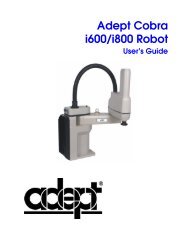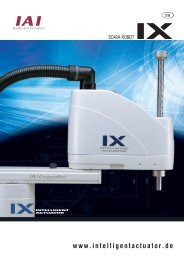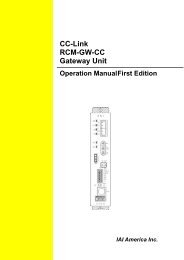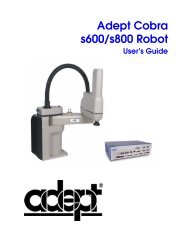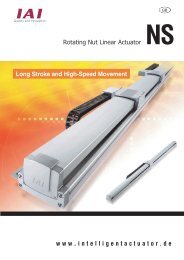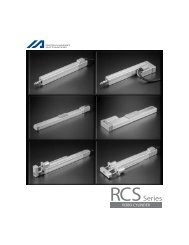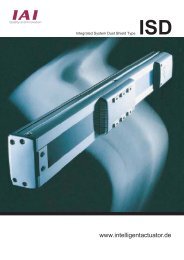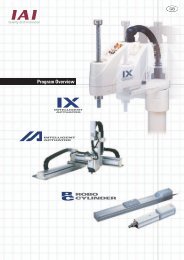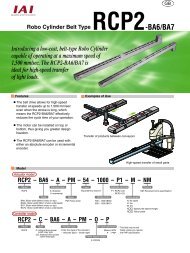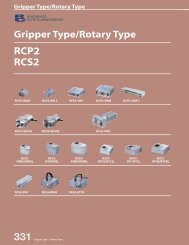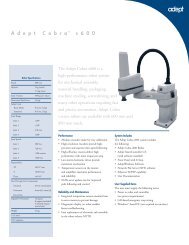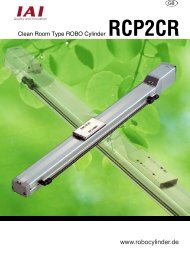Download Adept Cobra PLC600 User's Guide - pulsar.com.tr
Download Adept Cobra PLC600 User's Guide - pulsar.com.tr
Download Adept Cobra PLC600 User's Guide - pulsar.com.tr
Create successful ePaper yourself
Turn your PDF publications into a flip-book with our unique Google optimized e-Paper software.
Robot Concepts 10<br />
10.1 Understanding Robot Motion Parameters<br />
When programming a robot, there are several factors that play an important part in<br />
performance. In order to achieve optimum performance from your robot, it is helpful to<br />
have an understanding of how these factors work.<br />
Speed, Acceleration, and Deceleration<br />
Robot speed is usually specified as a percentage of normal speed, not as an absolute<br />
velocity. The speed for a single robot motion is set in N240:4 or <s<strong>tr</strong>ong>Adept</s<strong>tr</strong>ong> Speed (see page 81)<br />
for each individual location. Note that the result obtained by the speed value depends on<br />
the operating mode of the robot - joint-interpolated versus s<strong>tr</strong>aight-line (see<br />
“Joint-Interpolated Motion vs. S<strong>tr</strong>aight-Line Motion” on page 140 for details). Whether<br />
in joint-interpolated mode or s<strong>tr</strong>aight-line mode, the maximum speed is gated by the<br />
slowest-moving joint during the motion, since all the joints are required to start and stop<br />
at the same time. For example, if a given motion requires that the tool tip is rotated during<br />
the motion, which requires joint 4 to rotate, that joint could gate the maximum speed<br />
achieved by the other joints, since joint 4 is the slowest-moving joint in the mechanism.<br />
Using the same example, if joint 4 was not rotated, the motion could be faster without any<br />
change to the speed value.<br />
NOTE: The motion speed specified in N240:4 or <s<strong>tr</strong>ong>Adept</s<strong>tr</strong>ong>_Speed must<br />
always be greater than zero for a regular robot motion, or in the range<br />
-127 to 127 when jogging the robot. Otherwise, an error will be returned.<br />
You can use the acceleration parameter to con<strong>tr</strong>ol the rate at which the robot reaches its<br />
designated speed and stops. Like speed, the acceleration/deceleration rate is specified as<br />
a percentage of the normal acceleration/deceleration rate. To make the robot start or stop<br />
less abruptly, set N240:5 or <s<strong>tr</strong>ong>Adept</s<strong>tr</strong>ong>_Acceleration to a low value. To make the robot<br />
accelerate and decelerate more quickly, set N240:5 or <s<strong>tr</strong>ong>Adept</s<strong>tr</strong>ong>_Acceleration to a higher<br />
value.<br />
NOTE: The value of N240:5 or <s<strong>tr</strong>ong>Adept</s<strong>tr</strong>ong>_Acceleration must always be<br />
greater than 0. Otherwise, an error will be returned.<br />
The speed and acceleration parameters are <s<strong>tr</strong>ong>com</s<strong>tr</strong>ong>monly modified for cycle-time<br />
optimization and process cons<strong>tr</strong>aints. For instance, abrupt stops with a vacuum gripper<br />
may cause the part being held to shift on the gripper. This problem could be solved by<br />
lowering the robot speed. However, the overall cycle time would then be increased. An<br />
alternative is to slow down the acceleration/deceleration rate so the part does not shift on<br />
the gripper during motion start or stop. The robot can still move at the maximum<br />
designated speed for other movements. Another case would be a relatively high payload<br />
and inertia coupled with tight positioning tolerances. A high deceleration rate may cause<br />
overshoot and increase settling time. Higher acceleration/deceleration rates and higher<br />
speeds don't necessarily result in faster cycle times.<br />
<s<strong>tr</strong>ong>Adept</s<strong>tr</strong>ong> <s<strong>tr</strong>ong>Cobra</s<strong>tr</strong>ong> <s<strong>tr</strong>ong>PLC600</s<strong>tr</strong>ong>/PLC800 Robot User’s <s<strong>tr</strong>ong>Guide</s<strong>tr</strong>ong>, Rev B 137



